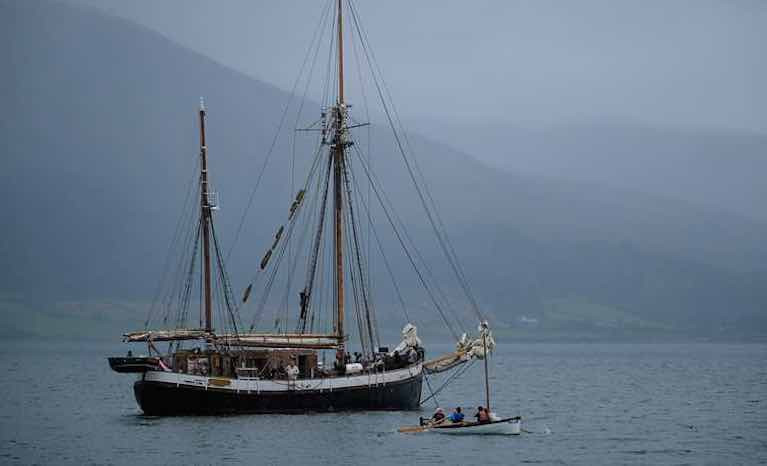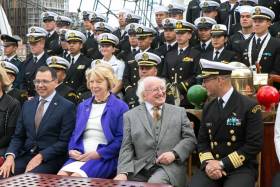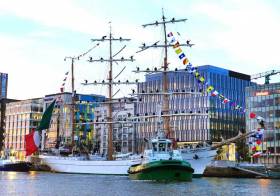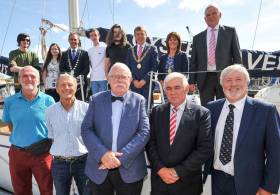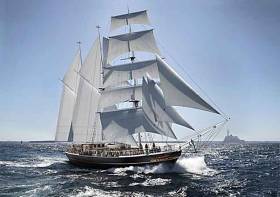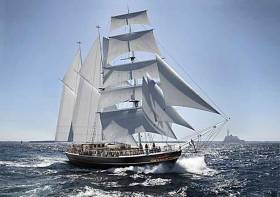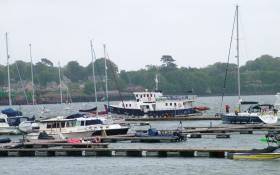Displaying items by tag: Tall ship
The impressive 65-metres long tall ship Danmark was assisted on the final stretch of her journey to Dublin by a Dublin Port pilot and the tug Shackleton early on Friday.
As Afloat reported earlier, after a nine-day voyage from Frederikshavn in Denmark, STV Danmark anchored in Dublin Bay on Thursday prior to her journey up the River Liffey as our pictures illustrate.
The 88-year old vessel, sailing under the flag of Denmark, is a fully equipped sail training vessel and weighs over 790 tons. She has an overall length with a beam of 32 feet (9.8 m) and a depth of 17 feet (5.2 m).
Manoeuvres in the comparatively tight surroundings of the river required Dublin Port to carry out a careful evaluation of the draft of the vessel in relation to the depth of water available, the expected weather plus tidal streams before working out what Port resources to allocate.
 (Above and below) Having assessed the risks in the manoeuvring capabilities of the vessel and the accessibility of her berth, the Harbourmaster and pilots decided one tug, the Shackleton, should accompany STV Danmark up the Liffey Photos courtesy: Finbar Harding
(Above and below) Having assessed the risks in the manoeuvring capabilities of the vessel and the accessibility of her berth, the Harbourmaster and pilots decided one tug, the Shackleton, should accompany STV Danmark up the Liffey Photos courtesy: Finbar Harding
The tug in this case, on the pilot's orders, and driven by tugboat diver Finbar Harding, would act as a brake if required as the ship approaches the East Link bridge and when approaching the berth. The tug also assisted in swinging the ship parallel to the berth.
Typically, the tug pushes the ship onto the berth, keeping the ship alongside until the ship's crew have made the mooring lines fast.



The full-rigged ship is owned by the Danish Maritime Authority.
Sail training voyages are offered onboard the vessel, not only to Danes but also to those of any nation interested in learning the basics of seamanship on a large sailing vessel.
The ship was one of the vessels that were used during the filming of the British BBC TV series Onedin Line (1971-1980).
Tall Ship Youth Training Vessel Requires Urgent Reinstatement of State Funding - Atlantic Youth Trust
Youth development, education and cultural charity the Atlantic Youth Trust have made a direct appeal to An Taoiseach, Micheál Martin TD and Minister Simon Harris TD, to reinstate the €950,000 which came from the National Lottery to support the operational costs of a new tall ship for Ireland. The charity made the call against the clear commitment in the Programme for Government to develop Ireland’s ocean wealth, sustainability, and the environment.
As Afloat reported earlier, the group says it has identified a ship to replace the lost Asgard II. The ship, the trust says, will act as the new ‘flagship’ for introducing young people across the island of Ireland to maritime and careers. In addition, it will have a key role to play in the areas of research, innovation, tourism promotion and providing a support outlet for vulnerable young people.
 Chair of the Atlantic Youth Trust, Enda O'Coineen
Chair of the Atlantic Youth Trust, Enda O'Coineen
Chair of the Atlantic Youth Trust, and former Director of Coiste an Asgard, Enda O’Coineen was introduced to the ocean and adventure on the original Asgard. He advocates for how this opportunity changed the course of his life and is joined by a high-level group of youth workers, people in business and academics behind the project. Commenting Mr O’Coineen said: “With a large research-led support base, we have long since championed for the need to replace Ireland’s lost sail training vessel the Asgard II in a dynamic and creative new way.
“This would be a strategically important move for ensuring we are well-positioned to maintain our island’s rich maritime heritage, skill set and knowledge. This will be vital for connecting future generations with the ocean and adventure who might normally never get the opportunity. As we emerge from the Covid 19 pandemic, the urgency for supporting projects like this has never been more important as we seek to address growing mental health challenges facing our young people.”
In looking for a solution to this, the Atlantic Youth Trust has identified, a 164ft Tradewind schooner lying in Sweden which is an ideally suited replacement for delivering youth maritime development and sail training.
 The 164ft Tradewind schooner lying in Sweden
The 164ft Tradewind schooner lying in Sweden
The ship is to be renamed the Grace O’Malley, after the so-called Mayo ‘Pirate Queen’. Built of steel in a modern structure, and elegant lines of a 19th century Tall Ship, she is considered fit for purpose to high safety specifications.
Mr O’Coineen added: “In our recent pre-budget 2022 submission to the Office of An Taoiseach and other Government Departments, we called for the reinstatement of an annual Government subsidy to assist with the day-to-day operational costs of a new vessel.
This funding was previously channelled through the National Lottery. Given the strong training and education remit planned for the new vessel, we believe it’s pertinent that Government funding, if reinstated, is directed via the Department of Further and Higher Education, Research, Innovation and Science, under Minister Simon Harris.
“To support our pre-budget submission, we also included a comprehensive business proposal outlining how the purchase of the identified successor ship will be funded through private and philanthropic sources. This can only happen if the State commits to reinstating the former Asgard II National Lottery funds to support the new ship’s operations budget. We believe the reinstation of these funds would go a long way in supporting a clear commitment made in both the Programme for Government and the Ocean Wealth Strategy to develop Ireland’s ocean wealth, sustainability, and the environment, integrated through the National Marine Co-Ordination Group”
In addition, the Atlantic Youth Trust are seeking a once-off commencement grant from Government of €880,000 to support refit costs, ensuring the ship is fit-for purpose with disabled access as well as the establishment of an organisation to run the ships operation. This commencement budget would represent approximately 20 per cent of the insurance funds retained by the State when the Asgard II was lost.
Head of the National Maritime College of Ireland and Atlantic Youth Trust advisory board member, Cormac Gebruer said: “To have a tall ship back in Ireland repurposed to introduce our younger generations to the maritime would be a significantly important and strategic development for the College. There are huge opportunities to utilise this initiative for research purposes linking in with human behaviour and marine sciences which would complement the work we are doing here in the College.
“The Atlantic Youth Trust has been an exemplary resource in leading a world-class solution for youth development integrated with the maritime across Ireland together with its focus on research and partnering with other colleges, such as NUI Galway. We at the National Maritime College of Ireland very much support the endeavours to secure a suitable replacement tall ship training vessel following the loss of the Asgard II.”
As Afloat reported at the time Asgard sank off the French coast in 2008. More details on the background to the sinking, campaign to raise and then replace her are in Afloat's dedicated Asgard II section
Co-founder of Sailing into Wellness and Atlantic Youth Trust advisory board member, James Lyons said: “Following a recent visit to Sweden to see the proposed successor ship in lying, I’m convinced that she will fire people’s imagination if brought to Ireland renamed as the Grace O’Malley. Built with submarine steel to the highest specifications and modelled on a classic wooden tall ship, she will make an ideal tall ship for Ireland with some small modifications.”
Once the Irish Government commits to the reinstatement of the Asgard II funding, additional financial support for the project will then be sought from the Northern Ireland Executive, with the initiative marked as a North-South venture. It’s envisaged that the ship will act as a fantastic promotional platform for tourism, enterprise, culture and the marine across the island of Ireland.
Chair of Tall Ships Belfast 2009 & 2015 and Atlantic Youth Trust advisory board member, Dr Gerard O’Hare said: “While there is an onus on the Irish Government to honour its commitment to supporting the maritime through the reinstatement of the Asgard II funding, there is also scope to seek support from the Northern Irish Executive once the project is up and running. This could include part-funding the initial fit-out planned for early 2022 in Belfast.”
Cobh had a Tall Ship visitor this week and the sight of her in Cork Harbour last night evoked memories of times past when brigantines such as Tres Hombres were common place in the harbour in the 1800s.
The visiting Tres Hombres is reviving this tradition and pointing the way towards a more sustainable future. She has no engine and travels the world's oceans exclusively under sail power, bringing non-perishable commercial cargos between ports.
As Cork Beo reports this is her second visit - and her second time picking up a delivery of several tonnes of Irish-brewed craft beers for delivery to Les Sables-d'Olonne on the northern Atlantic coast of France.
The ship is part of the Fair Transport Shipping and Trading Line which uses sail power - both classic and modern - to transport cargoes in a carbon-neutral, sustainable fashion.
Bob Bateman captured the ship on its departure from Cork last night for Afloat
It's 7000 km from the Caribbean island of Grenada to London and somewhat farther if you travel via Den Helder in the Netherlands, Carlingford Lough, the County Down village of Killowen and Bangor in North Wales. And this is how the Chocolate Maker NearyNógs on the edge of the Mourne Mountains forged close ties with Fortnum & Mason of Piccadilly in London, one of the oldest and most luxurious department stores on the planet, to help produce a 99% emission-free sailboat chocolate.
It is thus named because to transport the 25kg blocks of chocolate in a sustainable way as possible, the company looked back to its early 18th century roots and combined some old methods with modern green thinking to enable the 99% emission-free chocolate to be carried that 7,000 km. The chocolate's epic journey begins in the Grenada Chocolate Company's solar-powered factor in the West Indies, where the Trinitario cocoa beans are processed using zero emissions.
 The 30-metre engineless brigantine, the Tres Hombres Photo: courtesy Fair transport
The 30-metre engineless brigantine, the Tres Hombres Photo: courtesy Fair transport
So the first stage across the Atlantic used a 30m engineless brigantine, the Tres Hombres to carry the 350kg of chocolate, in 25kg blocks The ship is owned by Fair Transport. This company carries sustainable and organic cargo between South, Central and North America and Europe. Tres Hombres has become a shining example of the existing possibilities for alternative shipping methods, and she is the ambassador for sail-powered cargo shipping worldwide. Its destination was Den Helder in the Netherlands from where the chocolate began its second voyage on the T/S Britta, with Silvery Light Sailing under Capt Chris Wren, to Carlingford Lough on the east coast of Ireland where it moored close to Killowen on the northern shore.
But that was only part of the story. How to get the chocolate to NearyNógs? Now a team of volunteers heeded the call to transport the chocolate to the Neary family factory. The name NearyNógs comes from children's stories written by Johnnie Neary. Neary is the family name, and Nógs comes from the Irish Gaelic word Tír na nÓg, which means the land of the youth. This passionate team of volunteers used a Boyne Currachs Heritage Group's traditional open-ended clinker-built Drontheim rowing boat. After several trips ashore with the 48 boxes of chocolate, it was a bumpy 9 km by horse and cart to NearyNógs. There the chocolate was broken down into slates, tempered and packaged in recyclable, biodegradable packaging before the final leg of its adventure to Piccadilly.
 The Danish built ketch the Klevia Photo: courtesy Anglesey Traditional Sail
The Danish built ketch the Klevia Photo: courtesy Anglesey Traditional Sail
 The crew of the TS Britta
The crew of the TS Britta
That final leg began with return horse and cart, and Drontheim trips to another boat, the Danish built ketch the Klevia skippered by Scott Metcalf, which transported the cargo to Port Penrhyn, in Bangor, North Wales. And to complete the virtual emission-free the final leg of this sustainable journey was entirely on land, using Fortnum & Mason zero-emission electric vans to Piccadilly.
 The rowers (and the ship's dog) get ready to deliver another load of Chocolate slabs bound for NearyNógs Photo: Columba O’Hare
The rowers (and the ship's dog) get ready to deliver another load of Chocolate slabs bound for NearyNógs Photo: Columba O’Hare
The mission was made possible with the help of the local charity Silvery Light Sailing and a hard-working rowing crew at Killowen. Silvery Light Chairman Gerry Brennan was delighted to help in the arrangements. "As a Newry based sailing charity, we were pleased to be asked help local Mournes business NearyNógs organise the emission-free transportation of their chocolate using traditional sailing ships. Being a part of the story of the journey from the Caribbean to the shelves of Piccadilly is beyond our normal outreach. Still, it was great to help promote the maritime potential and scenic beauty of Carlingford Lough and the Mournes."
 Shane Neary, (right) of NearyNógs chats to Gerry Brennan, Silvery Light Sailing Photo: Columba O'Hare
Shane Neary, (right) of NearyNógs chats to Gerry Brennan, Silvery Light Sailing Photo: Columba O'Hare
Mexican Tall Ship in Dublin is Visited By President Higgins
President Michael D Higgins was welcomed onboard one of the world’s largest Tall Ships, the 270-foot-long Cuauhtémoc, which sailed into Dublin early this morning for a five-day visit to the capital.
As Afloat reported earlier, the ship is berthed at Sir John Rogerson’s Quay for the duration of her stay, and open to the public to visit, free of charge, on the following dates and times:
Having arrived from Hamburg, Dublin is the second-last stop on the ship’s 250-day training voyage of Northern Europe involving visits to 15 ports in 10 different countries (Canada, United Kingdom, France, Netherlands, Denmark, Norway, Germany, Ireland, Spain and Colombia).
Led by Commanding Officer Captain Carlos Gorraez Meraz, the Cuauhtémoc is an official sail training vessel of the Mexican Navy which travels around the world carrying a message of friendship and goodwill. This is the Cuauhtémoc’s fifth visit to Irish waters since her maiden call in 1998. She subsequently visited the capital in 2008, in 2012 as part of the Tall Ships festival and again in 2015.
The Mexican tall ship opens to the public to visit, free of charge, from Friday 6th to Monday 9th September at Sir John Rogerson’s Quay (11am to 8pm daily). See more here
Members of the public visiting the ship this weekend will be able to get a closer insight into life on board for the 257-strong crew and inspect the fine craftsmanship of the vessel which has trained more than thirty generations of officers, cadets, petty officers and sailors, both Mexican and other nationalities.
Commenting on the tall ship’s visit, The Ambassador of Mexico to Ireland, H.E. Miguel Malfavón said; “For over 40 years, Mexico has enjoyed excellent diplomatic relations with Ireland built on a shared sense of history and strengthening cultural, academic and trading ties in the present day. The arrival of the Cuauhtémoc reminds us of the affinity and friendship that exists between our two nations and symbolises the hand of friendship from Mexico to Ireland. For most of the crew on board, this is their first visit to Ireland, marking a new generation of Mexican-Irish exchange.”
Encouraging members of the public to visit over the weekend, Eamonn O’Reilly, Chief Executive, Dublin Port Company, said; “Tall Ship visits to Dublin are always a highlight and the Cuauhtémoc is no exception. This is a spectacular vessel and one of the finest working tall ships at sea today. I would encourage people in the city to take a trip down to Sir John Rogerson’s Quay to explore the Cuauhtémoc over the weekend and show her a warm Irish welcome during her stay. She brings a little piece of Mexico to our doorstep and it’s an opportunity not to be missed.”
Mexican Tall Ship Arrives in Dublin
Dublin Port Company and the Mexican Embassy in Dublin have welcomed one of the world’s largest Tall Ships, the 270-foot-long Cuauhtémoc, which sailed into Dublin early this morning for a five-day visit to the capital. She is berthed at Sir John Rogerson’s Quay for the duration of her stay, and open to the public to visit, free of charge, on the following dates and times:
- Friday, 6th September, from 11.00am to 8.00pm
- Saturday 7th September, from 11.00am to 8.00pm
- Sunday 8th September, from 11.00am to 8.00pm
- Monday 9th September, from 11.00am to 8.00pm
Having arrived from Hamburg, Dublin is the second-last stop on the ship’s 250-day training voyage of Northern Europe involving visits to 15 ports in 10 different countries (Canada, United Kingdom, France, Netherlands, Denmark, Norway, Germany, Ireland, Spain and Colombia).
Led by Commanding Officer Captain Carlos Gorraez Meraz, the Cuauhtémoc is an official sail training vessel of the Mexican Navy which travels around the world carrying a message of friendship and goodwill. This is the Cuauhtémoc’s fifth visit to Irish waters since her maiden call in 1998. She subsequently visited the capital in 2008, in 2012 as part of the Tall Ships festival and again in 2015.
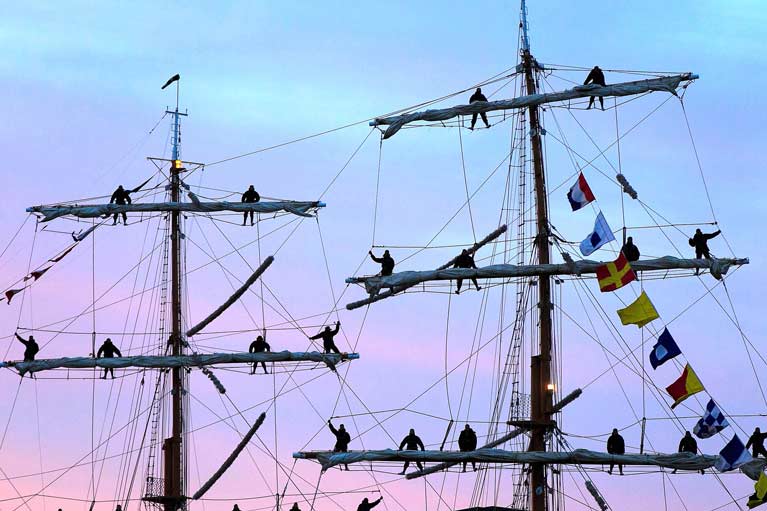 The Mexican tall ship opens to the public to visit, free of charge, from Friday 6th to Monday 9th September at Sir John Rogerson’s Quay (11am to 8pm daily). Photo: Shane O'Neill
The Mexican tall ship opens to the public to visit, free of charge, from Friday 6th to Monday 9th September at Sir John Rogerson’s Quay (11am to 8pm daily). Photo: Shane O'Neill
Members of the public visiting the ship this weekend will be able to get a closer insight into life on board for the 257-strong crew and inspect the fine craftsmanship of the vessel which has trained more than thirty generations of officers, cadets, petty officers and sailors, both Mexican and other nationalities.
Commenting on the tall ship’s visit, The Ambassador of Mexico to Ireland, H.E. Miguel Malfavón said; “For over 40 years, Mexico has enjoyed excellent diplomatic relations with Ireland built on a shared sense of history and strengthening cultural, academic and trading ties in the present day. The arrival of the Cuauhtémoc reminds us of the affinity and friendship that exists between our two nations and symbolises the hand of friendship from Mexico to Ireland. For most of the crew on board, this is their first visit to Ireland, marking a new generation of Mexican-Irish exchange.”
Encouraging members of the public to visit over the weekend, Eamonn O’Reilly, Chief Executive, Dublin Port Company, said; “Tall Ship visits to Dublin are always a highlight and the Cuauhtémoc is no exception. This is a spectacular vessel and one of the finest working tall ships at sea today. I would encourage people in the city to take a trip down to Sir John Rogerson’s Quay to explore the Cuauhtémoc over the weekend and show her a warm Irish welcome during her stay. She brings a little piece of Mexico to our doorstep and it’s an opportunity not to be missed.”
Built in the Celaya shipyards in Bilbao, Spain, the Cuauhtémoc was launched in July 1982. She was the last of four windjammers built by Bilbao shipyards and is named after the last Aztec Emperor who was imprisoned and executed by the conquistador, Hernán Cortés, in 1525. This is her fifth visit to Irish waters.
Cork Sail Training Bursary Awards Celebrate Tall Ship Voyage Achievements
A presentation ceremony took place in the Port of Cork to celebrate the achievement of 26 young people from all backgrounds and a range of abilities across Cork City and County who completed voyages aboard the Cork-Based Vessel Spirit of Oysterhaven and the Tall Ship Pelican of London during the 2017 season. These voyages were made possible by a group of generous sponsors including Port of Cork, Cork City Council, Cork County Council, Dell, Ardmore Shipping, Enterprise System Partners, The Institute of Master Mariners and the National Maritime College of Ireland.
Four trainees from the City and County crewed the Pelican from Dublin arriving in Belfast after 12 days exploring around the Irish sea. The Pelican was due to call to Cork during this voyage but unfortunately was forced to turn back due to adverse weather. Another two Cork trainees sailed from Belfast to Liverpool and on to Dublin over 10 days. These trainees formed part of groups with up-to 28 trainees and mentors on each voyage which were part funded using EU “Erasmus +” funding and involved active educational programmes of youth development as part of “Youth Exchange” projects.
In addition 20 Cork based young people took part on two six day voyages on the gorgeous local vessel Spirit of Oysterhaven. These lucky trainees enjoyed the beautiful coastline scenery while sailing between Glandore and Cork.
The Cork Sail Training Bursary Scheme was established in 2014 to provide access to Sail Training voyages on tall ships and large sailing vessels for young people from the region. Now in its fourth year the scheme is one of the largest and most active on the Island of Ireland and runs in parallel with similar schemes now in operation under Sail Training Ireland in Belfast, Drogheda, Dublin, Waterford, and Galway. The participants are nominated through a network of youth and community groups in Cork and places are available to young people from all backgrounds and with all abilities. The scheme has supported approximately 80 trainees since 2014 and looks likely to grow from strength to strength over the coming years.
Also present on the day were trainees straight off the “Spirit of Oysterhaven” having finished their recent voyage today (day of event 1st of September), following 6 days at sea beginning in Glandore County Cork. The vessel was alongside in Port of Cork during the event and opened to visitors afterwards.
“Our young people returned to us not just with new experiences but new skills, new friendships and new directions for the future.” Cork Life Centre.
Speaking at the presentation ceremony, Brendan Keating Chief Executive said: ‘The Port has been involved with Sail Training Ireland for a number of years now and has supported many voyages for young adults. We feel this is a very worthwhile initiative for the Port of Cork which teaches seamanship, teamwork, personal development and importantly gives them an awareness of life at sea. We would like to commend all 26 of the young trainees today and wish them the very best for their futures.’
MC for the event was former RTE Radio “SeaScapes” Presenter Marcus Connaughton (Goodwill Ambassador for Sail Training Ireland) and the certificates were presented to trainees by Lord Mayor of Cork City Tony Fitzgerald, County Mayor Declan Hurley and Commodore Hugh Tully Flag Officer Commanding Naval Service (F.O.C.N.S.). The Naval Service is a strong supporter of Sail Training for young people as a stepping stone into maritime careers.
Back in June I asked if there was sufficient joined-up thinking about the project for a new Irish tall ship – and why the Naval Service hasn’t taken a more active role in Irish sail training over the years, with advantages to itself, comparable to what the Royal Navy does in Britain…you can read that story here.
Neil O’Hagan, Executive Director of the Atlantic Youth Trust, organisers of a new national tall ship project, sent me an email saying that it is good to see discussion about the project so that it gets attention… but that “there is more going on than meets the eye…”
On this week’s Podcast, I indicate that I am glad to hear that, but I have reservations and will be convinced about actual Government support when I see it delivered…
Listen to the Podcast below…
Irish Sail Training Ship Hopes Given Boost by Taoiseach Leo Varadkar at Galway Seafest
The up-beat mood of the weekend’s Galway Seafest was moved several notches higher by Taoiseach Leo Varadkar, when he revealed at Galway Port that his government is broadly in favour of the concept of an all-Ireland sail training ship, which is promoted by the Atlantic Youth Trust writes W M Nixon.
The recent turbulence in Irish politics had induced a mood of pessimism about any implementation of this complex project, with some of the difficulties involved being outlined recently in Afloat.ie. However, we indicated the likelihood that, if such an idealistic scheme were ever to achieve fruition, then it would most likely be through the Enda O’Coineen-inspired Atlantic Youth Trust, whose Chief Executive, the popular Neil O’Hagan, has been quietly beavering away lobbying on the project’s behalf on both side of the Irish border. 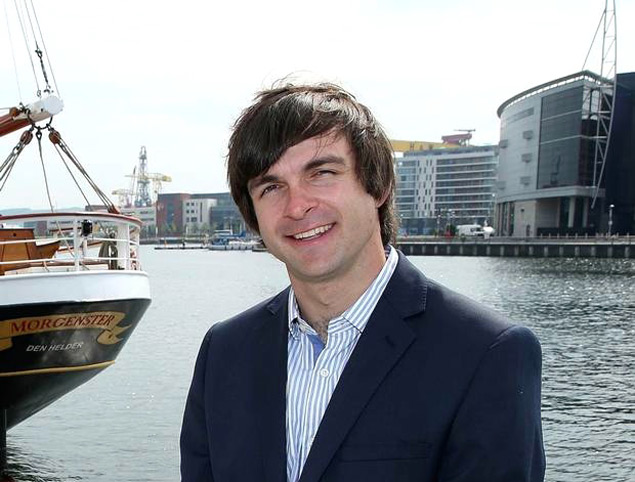 Neil O’Hagan of the Atlantic Youth Trust has lobbied tirelessly for a Tall Ship to Governments on both sides of the Irish border
Neil O’Hagan of the Atlantic Youth Trust has lobbied tirelessly for a Tall Ship to Governments on both sides of the Irish border
For O’Hagan, the story from Galway by Lorna Siggins in the Irish Times is well-earned encouragement in his challenging quest. The Taoiseach said that sail training was “one of the areas where we could have North-South co-operation, and also very important cross-community co-operation”.
He acknowledged that many people deeply regretted that the sail training brigantine Asgard II was no longer available, but indicated that his government is well aware of the €16 million cost of a replacement. Nevertheless his own enthusiasm for the concept was in evidence, and he clearly stated that discussion about the new ship “’is certainly something we can engage in”.
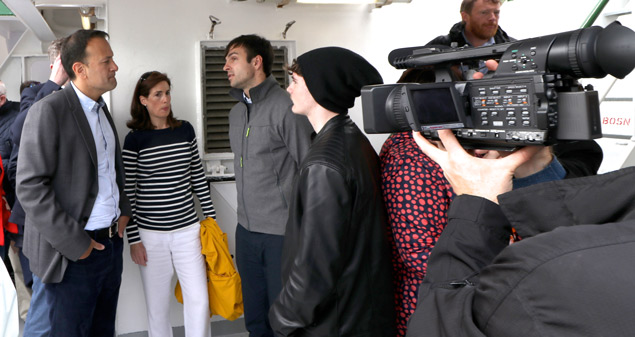 On board together. Aboard ship in Galway, Taoiseach Leo Varadkar TD, Hildegarde Naughton TD, and Neil O’Hagan of Irish Atlantic Youth Trust discuss the possibilities for Ireland’s 40-metre Sail Training Barquentine
On board together. Aboard ship in Galway, Taoiseach Leo Varadkar TD, Hildegarde Naughton TD, and Neil O’Hagan of Irish Atlantic Youth Trust discuss the possibilities for Ireland’s 40-metre Sail Training Barquentine
Hello and you’re welcome to my weekly podcast on Afloat, based on my This Island Nation radio programme.
While debate continues – and so do efforts – to get another Tall Ship for Ireland – that would provide sail training at a time when there are some people questioning whether it is worth the trouble ... and at the same time Sail Training Ireland, as the National Sail Training Organisation, provides opportunities for sail training, I had a very interesting discussion aboard a 24-metre vessel which carries out this task, was built at a cost of stg£2.6m and was launched eight years ago with a 25-year lifespan.
This is the TS Jack Petchey where, through the good offices of James O’Brien who runs Monkstown Marina in Cork Harbour where the vessel was making a crew and trainees change/over, I had an interesting chat with Royal Navy Lt.Tom Forster in command.
You can hear him on my Podcast below as he explained how the vessel is operated by the Sea Cadet Corps, a national youth organisation sponsored by the United Kingdom's Ministry of Defence and the Royal Navy. It is the UK’s largest naval cadet force, with over 19,500 cadets and adult volunteers. It was founded back in 1856 and also operates the Tall Ship Royalist and other vessel.
Tom Forster told me about the vessel:
Now, why does our Department of Defence and the Naval Service not have a similar involvement with sail training? Wouldn’t a sea cadet corps, with a focus on the Navy be a valuable potential recruiting source?


























